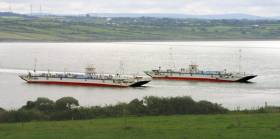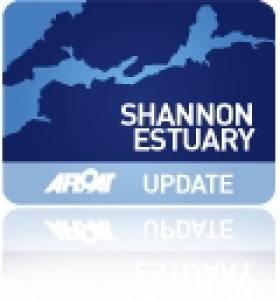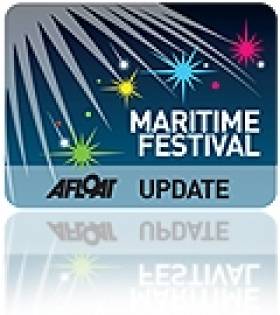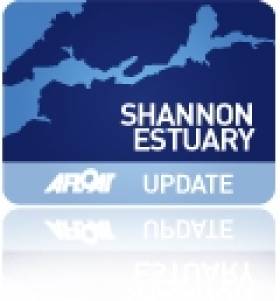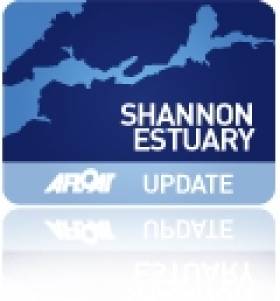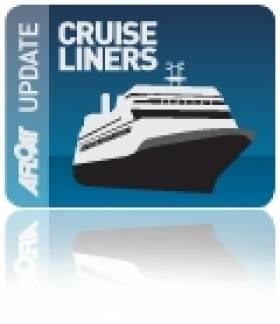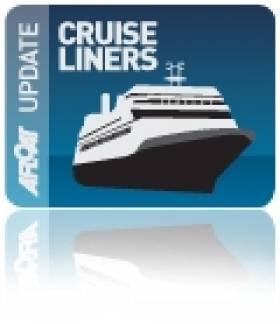Displaying items by tag: Shannon Estuary news
Foynes Port Rejects Warnings About Shannon Water Extraction
#ShannonWater - Plans for a pipeline by Irish Water to Dublin are no threat to activities says Shannon Foynes Port Company.
The mid-west port writes The Irish Times, has rejected warnings that Irish Water’s planned extraction of water from the river Shannon for Dublin homes and business could hit operations at Limerick port.
Campaigners against the proposed pipeline said it believed Irish Water’s plan to take out 330 million litres a day from the Shannon could lower water levels at the mouth of the river.
“If there isn’t sufficient strength of speed and flow – that is, if there is less water – the shipping channels will silt up and ships will not reach Limerick port. That would be a massive economic blow,” said Gerry Siney of the River Shannon Protection Alliance.
Port authorities said they were satisfied the pipeline would not “materially impact” dock operations at the facility, which relies on deep-water channels for much of its traffic.
Mr Siney described the plan as “ludicrous”, adding: “This really doesn’t stand up environmentally, economically and socially.”
For more the newspaper has a report here.
Frequency On Shannon Shifts to Winter Schedule
#Schedule -Ireland’s longest river crossing by car ferry, operated by Shannon Ferries, have introduced a winter schedule timetable, writes Jehan Ashmore.
A winter sailing frequency on their 20 minute crossing of the estuary along the Wild Atlantic Way, between counties Clare and Kerry was introduced last weekend.
According to the operator, there will be single ferry operating with sailings from Killimer to Tarbert every hour on the hour from 7am to 7pm.
For crossings in the opposite direction, sailings from Tarbert to Killimer are every hour on the half hour from 7.30am to 7.30pm. Whereas, Sunday sailings commence two hours later.
The winter sailing continuous to 31st March, 2017, from thereon a revised schedule begins for April and May in advance of high-season traffic over the summer months.
Carrying a mix of vehicle types, including coaches and HGV’s, are a pair of UK built double-ended ro-ro half-sisters ferries. Shannon Dolphin (52 cars/350 pass) and the slightly larger Shannon Breeze, albeit in terms of a 60 vehicle capacity.
The ferries were purpose built by Appledore Shipbuilders, north Devon, during 1995 and 2000 respectively.
.
Port of Foynes €50m Investment Redevelopment
#FoynesPort - Work on a major restructuring of Foynes Port, Co. Limerick according to RTE News involving the first element is to begin this month.
The project is part of a €50 million investment in transforming the port into one of the biggest bulk harbours in Europe.
Shannon Foynes Port Company (SFPC) will spend €12 million on transforming the existing East jetty area, and reclaiming a 3.45 acre section of the port to create a bigger foreshore area of activity and enable improved bulk discharge times.
The expansion of the port will add an additional 35,000 square metres of additional bertage and create more open quay storage at the port. It will enable the company to accommodate larger container cargo ships, enabling ships of 40,000 tonne capacity to berth at the new port.
In time it will create capacity for the worlds largest cargo vessels of 80,000 tonne capacity to travel and unload at Foynes, making it one of the few ports in Europe capable of handling these massive ships. These are the types of vessels which are currently using the Panama Canal.
Click HERE for more on this story and photos and about SFPC which in 2013 launched its Masterplan Vision 2041.
#FoynesFestival – This year's Foynes Irish Coffee Festival takes place this coming Bank Holiday weekend (31 May-2 June), writes Jehan Ashmore.
The history of the 'Irish' Coffee which started 70 years can trace its origins back to the flying boats that flew across the Atlantic. It was along the banks of the Shannon Estuary that the Irish Coffee was invented as a unique treat to visitors during their en-route stopover between the continents.
The highlight of the festival will culminate on the final day (Sunday 2 June) when the Powers Irish Coffee Making Championship Final 2013 takes place at Foynes Flying Boat Museum.
As previously reported on Afloat.ie, the same venue in March opened a new Maritime Museum charting the history and role of shipping along the Shannon from the mouth of the estuary to Limerick Docks.
On the Saturday and Sunday are the Munster Mermaid Championships at the Foynes Yacht Club from where RIB tours will run into the estuary as part of the festival. In addition public tours of the Naval Service CPV L.E. Ciara (P41) are available during the weekend.
In addition to nautical events, the three-day festival includes other activities for all the family, visit the festival website for details of times of the full programme.
Shannon Foynes Port Company Records €2.9m Profit
#SHANNON FOYNES – An operating profit close to €2.9m for last year (up from €2.5m in 2011) was recorded by Shannon Foynes Port Company (SFPC) according to yesterday's Irish Times.
SFPC recorded a 2.2 per cent rise in turnover to €10.1 million, resulting in a 13 per cent increase in operating margin from 25.5 per cent to 28.1 per cent, according to the 2011 annual report.
The company made a profit attributable to the shareholder of €2.73 million after exceptional items and financing. Cargo increased 8 per cent to 10.1 million tonnes from 9.4 million tonnes in 2010. About 35 per cent of Ireland's bulk traffic transits through SFPC's six terminals on the estuary.
Discounted Ferry Fares across the Shannon
#SHANNON FERRY SERVICE - With the May Bank Holiday looming, those travelling along the mid-western seaboard should note that Shannon Ferries are currently offering discounts of 10% on all 'on-line' tickets booked this month and in June, writes Jehan Ashmore.
The route operated by the Shannon Ferry Group, is the country's longest distance domestic car-ferry service between Killimer-Tarbert and takes 20-minutes to cross the estuary.
In total the short-cut can save 137km by road between the two ferry terminals which link counties Clare and Kerry. Alternatively there is the choice of bridging the Shannon in Limerick City or going underground via the tolled tunnel.
Strategically the route links the popular tourist trail linking the Ring of Kerry, Aran Islands (via the Doolin ferry) and Galway the gateway to Connemara.
The route is served also by the country's largest coastal car-ferries the Shannon Dolphin (1995/500grt) and Shannon Breeze (2000/611grt). They were built by Appledore Shipbuilders in north Devon, which also built the two 'Roisin' class OPV's for the Naval Service over a decade ago.
The 'Breeze' can handle 60 cars and 350 passengers while the slightly smaller 'Dolphin' takes 52 cars and also the same number of passengers to her running mate.
Masterplan for Shannon Foynes Port Company
Port expansion options are to be examined so to prepare ports for larger trade volumes when the opportunities arise. Also under consideration are the non-core assets at the Port of Foynes and Limerick Docks. To read more about the masterplan and the challenges and issues that has been identified in both ports click HERE.
The statutory jurisdiction of the estuary is under the control of SFPC, which is responsible for the estuary that runs from the mouth entrance marked by Kerry and Loop Heads and stretching far inland to Limerick City. The natural waterway can handle vessels of up to 200,000 deadweight tonnes (dwt) which are the largest ships that can dock in Irish waters.
Small Luxury Cruiseship Visits Killybegs
In 2004 Killybegs received a significant boost in the completion of a €50m outer harbour with berthing quays totalling 350-metres long so to accommodate the north-west fleet and to include the 'supertrawlers'.
Despite the major port infrastructural investment, Killybegs has seen declining fortunes in the fish industry though in recent year's new business from the offshore exploration and cruise ship industries has assisted in generating new revenue.
Loop Head: A Guiding Light for Foynes-Bound Cruise Calls
Her arrival will be followed by P&O Cruises latest addition Adonia on Saturday. With 710 berths the 30,000 tonnes vessel is the smallest of the seven-strong fleet which can accommodate between 1,800 and up to 3,100 passengers as in the case of the Azura. The 115,000 tonnes vessel departed Dublin Port this evening. Her first call to the port was last year (click HERE) and she is the largest cruise ship to call to the capital.
On Tuesday of next week the 9,000 tonnes Spirit of Adventure (cruises) marks the third cruise caller to Foynes. The port is along with five other terminals located throughout the country's largest estuary are operated by the Shannon Foynes Port Company (SFPC).
Incidentally Spirit of Adventure and Azura where two of another trio of cruise ships that visited the Port of Cork on Monday, with Holland America Line's 59,000 tonnes Rotterdam forming the third vessel. This was the first occasion that Cork has handled this number of cruise ships on a single day, bringing 7,000 passengers which set a new record for the port.
- Shannon Estuary
- Shannon Foynes Port Company
- P&O Cruises
- Loop Head
- Cruiseships
- lighthouses
- Dublin Port news
- Holland America Line
- Port of Cork News
- Le Diamant
- Cruiseliners
- Spirit of Adventure
- Shannon Estuary news
- Loop Head Lighthouse visitor centre
- Azura cruise ship
- Spirit of Adventure cruiseship
- Adonia cruiseship
- Rotterdam cruiseship
- Loop Head Lighthouse
- Shannon Estuary and River
- Shannon Estuary and River news
- Lighthouse news
- Irish cruise calls
- Irish ports of call
- Foynes Port

